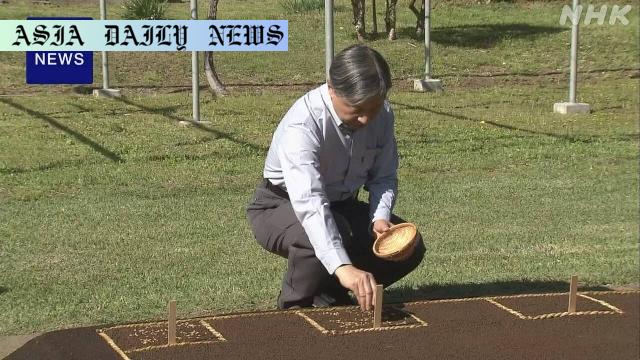Emperor Naruhito participates in a heartful ceremony by planting rice seeds, continuing a meaningful royal tradition in Japan.
Emperor Naruhito plants rice seeds in an annual tradition.
The tradition originated from Emperor Showa’s era.
Harvested rice will be offered in Shinto rituals.

Introduction to Emperor Naruhito’s Revered Rice Sowing Ceremony
Japan’s Emperor Naruhito has once again participated in a deeply significant annual event at the Imperial Palace in Tokyo—planting rice seeds. This tradition highlights the Japanese monarchy’s connection to agriculture and its commitment to promoting farming practices. Emperor Naruhito, dressed modestly in everyday attire of a blue shirt and gray trousers, signified his respect for this humble, yet symbolic activity in Japanese culture.
The annual custom of rice planting has been passed down through generations of imperial monarchs. It began with Emperor Showa, who first initiated this practice, followed by Emperor Emeritus Akihito, and now Emperor Naruhito. This ongoing tradition reflects a continuity of respect for Japan’s agrarian roots while also serving as a poignant reminder of the vital role agriculture plays in sustaining life and culture.
Details of the Sowing Event
The ceremony took place on a peaceful afternoon with birds quietly chirping in the background. Emperor Naruhito personally sowed two carefully selected varieties of rice seeds from last year’s harvest—demonstrating a symbolic connection to past agricultural successes. These were planted across meticulously measured plots of 30-by-30 centimeters, totaling around 180 seeds in each small area marked by ropes. In this serene and deliberate process, the Emperor showcased precision and care, aligning perfectly with the spiritual and cultural essence of the tradition.
The care exhibited during the sowing also serves as an educational moment, emphasizing the importance of detail, respect for the earth, and the value of patience. Within approximately a week, the seeds are expected to sprout, symbolizing life and growth. This natural process resonates deeply with Shinto beliefs, which honor nature and its connection to humanity.
Significance of the Tradition
The annual rice planting is more than just a symbolic act. By taking part in the planting personally, the Emperor embodies a sense of unity with the Japanese people, particularly those engaged in agriculture. It highlights the close relationship between the monarchy and the nation’s cultural traditions. Further, it illustrates the importance of agriculture and encourages sustainable farming practices that hold historical and spiritual value in Japan.
Rice, being a staple food in Japan, also has significant religious connotations. The Emperor’s participation in this tradition serves not only as physical labor but also as a spiritual offering. The harvested rice will later play a major role in traditional Shinto rituals, such as the Niiname-sai harvest festival in November, which is dedicated to expressing gratitude for the season’s bounty and praying for prosperity in the next cycle.
Looking Ahead: From Seed to Harvest
In the coming months, the seeds sown by Emperor Naruhito will grow into seedlings, which he will personally plant in May within a designated rice paddy at the palace grounds. This act will symbolize a further step in the process of cultivation, showcasing dedication and continuity. Finally, in autumn, the rice will be harvested and used in sacred rituals, blending modern agricultural practices with ancient traditions.
This entire cycle—from sowing to offering—represents the interconnectedness between humankind, nature, and spirituality. As Japan continues to evolve, this tradition remains a cornerstone of its deep respect for agricultural heritage and its enduring cultural values.
Commentary
The Cultural Depth of Emperor Naruhito’s Rice Sowing Tradition
The annual rice planting ceremony by Emperor Naruhito is a profound spectacle that weaves Japan’s rich cultural history with its modern identity. This tradition not only keeps the legacy of Emperor Showa alive but also acts as a bridge between generations, connecting the past with the present. It’s a gesture steeped in humility, showing that even those in positions of great power acknowledge their dependence on the earth and its resources.
The Spiritual Significance of Agriculture in Japan
One cannot overlook the deep spiritual connotations of this tradition. In Shintoism, the religion intrinsic to Japan’s culture, nature holds a sacred role. The act of planting rice, nurturing it, and offering it back to the deities signifies gratitude and reverence for life. Emperor Naruhito’s participation underscores how traditions help preserve these beliefs amidst the rapid pace of modernity. Such rituals offer not only a sense of continuity but also an opportunity to reflect on the harmonious relationship between humanity and nature.
A Tradition With Lessons for the Future
The legacy of the Imperial Family’s rice sowing ceremony is a powerful symbol of sustainability and respect for agricultural practices. In a world increasingly detached from nature, this annual event serves as a reminder of the vital importance of preserving farming methods, prioritizing sustainable growth, and appreciating the resources we often take for granted.
Through these gestures, Emperor Naruhito provides a living example of how to honor traditions while adapting to the changing times. As Japan moves forward, this tradition will likely continue to inspire its citizens and the world, rooting progress firmly in the fertile soil of history and spirituality.


